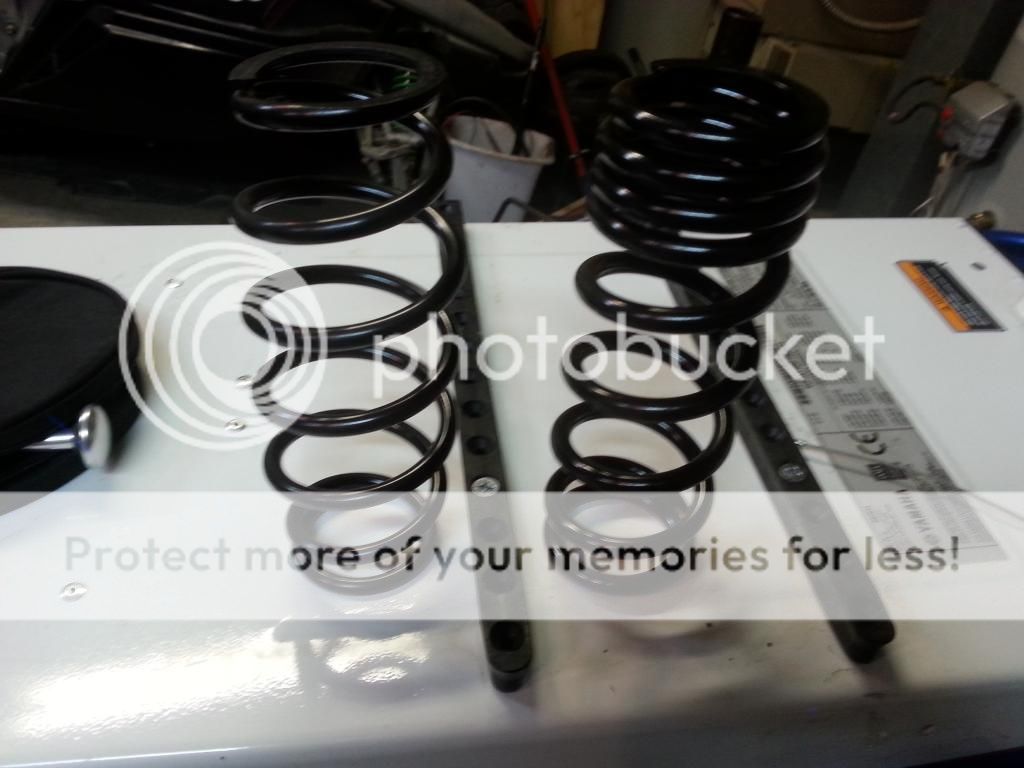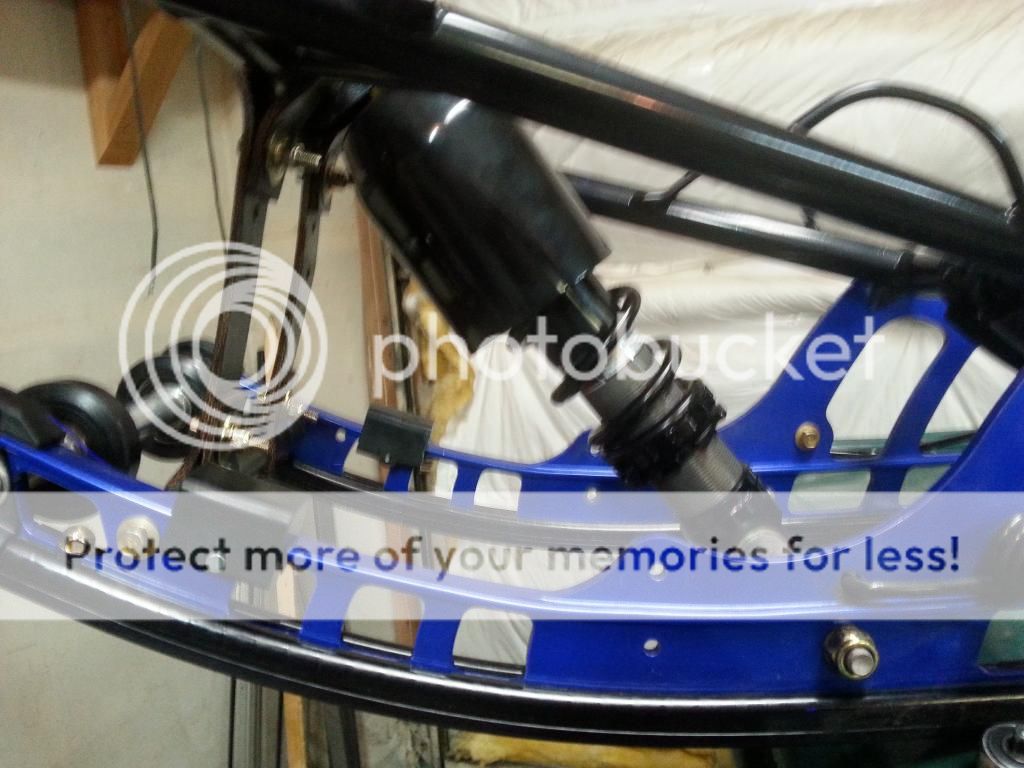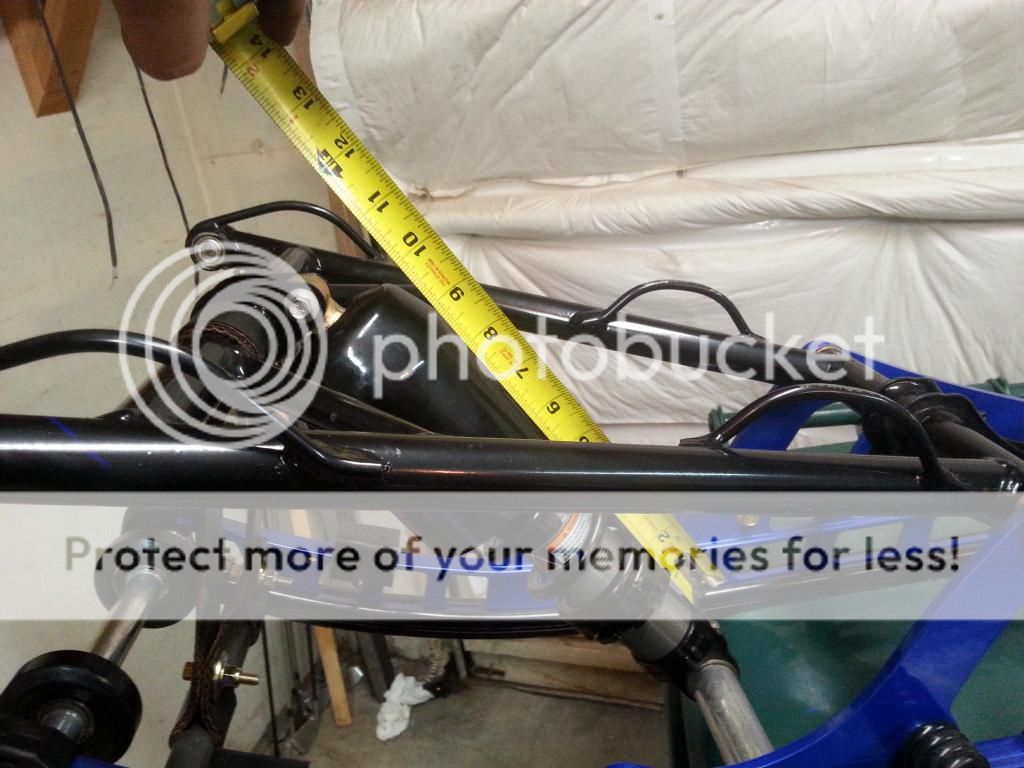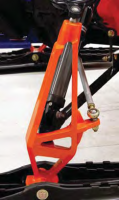stingray719
TY 4 Stroke God
This thread http://www.ty4stroke.com/threads/interesting-skid-shock-spring-info.131147/ was for the XTX but now I am seeing the MTX comes with a 110 pound front skid shock spring also. Huge help in overall handling by changing it, see the thread above
Mountaintech
TY 4 Stroke God
Thanks for posting the info!
Tricky Nick
Going Vertical
- Joined
- Mar 23, 2014
- Messages
- 229
- Location
- Eagle River, AK
- Country
- USA
- Snowmobile
- 2015 Viper MTX 162 Turbo
Back up sled AC M7
Ride report:
The heavier spring (145#) definitely helped. I think I need to go more pre-load though. I set it at 1/4" pre-load or 1.750" from the bottom. I'm going to turn it up another 1/4" for a total of 2" from the bottom. That will still leave another 7/8" of thread left for additional tuning.
Just a heads up, my spring is 1/4" longer than the stock spring, so my #'s my not directly cross over to stock!
This thread got me thinking. On my first ride the first thing i noticed was the very heavy steering just tooling around in the parking lot. Now once i got in the pow i didnt notice it so much, it was just that short bit of trail getting to the mountains that was very noticable. I was reading that AC switched to a lighter spring on the Proclimb chassis to allow the sled to climb onto and float in the powder a lot easier. I see Turbo800 went with a 145# spring and still had to pre-load it quit a bit. Well im a bit of a fat azz at 265 so im thinking of odering the AC 2704-229 its a 160# spring with the same I.D. and free length as stock. My two fears are (1) that the sled might trench more with the heavier spring not letting the front of the skid climb onto the snow and (2) with that high of a jump in the spring rate i think rebound might make the seat jump up and take a bite of my nuts from time to time after a big drop or jump so i'm thinking a revalve would be necessary
turbo800
Pro
- Joined
- Jul 24, 2014
- Messages
- 137
- Location
- UT
- Country
- USA
- Snowmobile
- '15 Viper MTX 162 LE w/ MPI 180 turbo
One thing to keep in mind is that I was running 8" powderhound skis. These tend to have additional bite and require more effort to turn. I took them off and went back to the stock skis because in minimal fluffy snow, I couldn't find a balance point on them. It either wanted to lay flat or roll all the way over on its side. If I do any other skis it will be either the Poo gripper or the C&A BX ski. I think with the stock ski I could probably soften my preload now. Keep in mind Nate @ Zbroz sends all his stuff out with either 140 or 160 center spring. The 160 is more common on the trail or race sleds. For the price, it's worth trying the CAT spring!
Tricky Nick
Going Vertical
- Joined
- Mar 23, 2014
- Messages
- 229
- Location
- Eagle River, AK
- Country
- USA
- Snowmobile
- 2015 Viper MTX 162 Turbo
Back up sled AC M7
Ill be running the 7" powderhounds when the snow gets deep enough had them on my M7 last year and liked them. Yeah when i looked at the (where part is used) in the AC parts manual i did see that the 160 comes stock on the 600RR @ $40 for the spring its cheap enough to give it a try
stingray719
TY 4 Stroke God
Ill be running the 7" powderhounds when the snow gets deep enough had them on my M7 last year and liked them. Yeah when i looked at the (where part is used) in the AC parts manual i did see that the 160 comes stock on the 600RR @ $40 for the spring its cheap enough to give it a try
Changing the front skid shock spring made a HUGE difference on both my Vipers. I strongly suggest it.
loudelectronics
TY 4 Stroke Guru
Anyone doing this must realize it depends on there ride weight. There is more to it than just changing spring rates. Using to much center shock pressure makes the machine trench easier. If you are a trail rider this mod works really well and even helps the machine turn sharper and feel fore nimble at speed on trail. If that spring G rate is to high for your weight in the off trail the machine will trench. If you can get a set of scales you want the rear skid to carry your weight evenly. You can do this by adjusting the spring rates, ride heights and air pressures of the front center and rear shock. Also want to have about 1.5" of ride in (sag) with rider at rear bumper.
stingray719
TY 4 Stroke God
Anyone doing this must realize it depends on there ride weight. There is more to it than just changing spring rates. Using to much center shock pressure makes the machine trench easier. If you are a trail rider this mod works really well and even helps the machine turn sharper and feel fore nimble at speed on trail. If that spring G rate is to high for your weight in the off trail the machine will trench. If you can get a set of scales you want the rear skid to carry your weight evenly. You can do this by adjusting the spring rates, ride heights and air pressures of the front center and rear shock. Also want to have about 1.5" of ride in (sag) with rider at rear bumper.
"Using to much center shock pressure makes the machine trench easier" Yep couldn't agree more, but define "to much"? You had the same problem going by this post in another forum,
"Less weight on skis with Timbersled skid
Anyone have any tips to reduce the ski pressure when using a timbersled skid? This is on a viper 162. The skis just stick to the ground when backing up or even going forward as the track just spins under the sled. On my Nytro MTX with stock skid but Skinz front end the amount of weight on skis is minimal and very easy to steer and the track does not spin when backing up or forward. Just not sure how to set up this viper with timbersled skid to get it to feel the same. I think this has something to do with why it just nose bombs in deep snow and gets stuck and why my nytro does not. "
I have found a solution to the problem XTX and MTX Vipers are having in that they are WAY to weak on the front spring. As you said "to much" causes trenching, but having a very weak spring puts the weight on the skis and back of the track and causes trenching. How do I know this? Putting the 135 pound spring in mine makes it trench less. Aftermarket folks are using the 160 pound spring and I believe I am going to test that next, as I am already half way through my adjustment on the 135 spring. Sorry to sound harsh but criticizing something that every one that has tried it says it works will almost always get a response.
For the record my Viper goes places my 162 Nytro Supercharged could only hope too. In this pic I pulled up and stopped and after the pic drove off without spinning the track in Colorado bottomless powder, getting the weight placed correctly makes this sled makes a whole new machine.
loudelectronics
TY 4 Stroke Guru
Stingray that is what I am saying. It's a fine balance. I had to add air to my center shock to balance rear shock. Also needed more up front as well. Just saying for some with a mountain sled it may not be an option especially if a light weight rider. Trail sled totally agree.
What I did with mine was I got 4 digital shipping scales and put them under each shock mount. I then stood on sled and adjusted the air pressures until everything evened out. My steering is now light and my sled now feels more like my nytro mtx which was light on its feet. I found I actually had to much air in rear shock. As I had not enough tide in. Once that was dialed it made a huge difference. More tuning to come as just got dumped on last night and then heading to Cooke City next weekend.
What I did with mine was I got 4 digital shipping scales and put them under each shock mount. I then stood on sled and adjusted the air pressures until everything evened out. My steering is now light and my sled now feels more like my nytro mtx which was light on its feet. I found I actually had to much air in rear shock. As I had not enough tide in. Once that was dialed it made a huge difference. More tuning to come as just got dumped on last night and then heading to Cooke City next weekend.
stingray719
TY 4 Stroke God
Stingray that is what I am saying. It's a fine balance. I had to add air to my center shock to balance rear shock. Also needed more up front as well. Just saying for some with a mountain sled it may not be an option especially if a light weight rider. Trail sled totally agree.
What I did with mine was I got 4 digital shipping scales and put them under each shock mount. I then stood on sled and adjusted the air pressures until everything evened out. My steering is now light and my sled now feels more like my nytro mtx which was light on its feet. I found I actually had to much air in rear shock. As I had not enough tide in. Once that was dialed it made a huge difference. More tuning to come as just got dumped on last night and then heading to Cooke City next weekend.
Cool. BTW I am 165 pounds and with the mod above the sled is almost perfect. I am going to put the cat spring 2704-229 in next as I am already using half the adjustment on the 135# spring and I need a little more. So yes for some it may not be right but for a lightweight rider in deep powder it truly rocks for me. And everyone so far that tried it liked it.
Maybe I am a little sensitive about criticism from folks that have not tried my mods as I get a lot of that, if so sorry if I came across harsh.
Tricky Nick
Going Vertical
- Joined
- Mar 23, 2014
- Messages
- 229
- Location
- Eagle River, AK
- Country
- USA
- Snowmobile
- 2015 Viper MTX 162 Turbo
Back up sled AC M7
I am going to put the cat spring 2704-229 in next .
Same one i just ordered. Ill install next week and hope fully have a ride in by Thursday or Friday and report back
Tricky Nick
Going Vertical
- Joined
- Mar 23, 2014
- Messages
- 229
- Location
- Eagle River, AK
- Country
- USA
- Snowmobile
- 2015 Viper MTX 162 Turbo
Back up sled AC M7
Installed the cat 160# spring Monday. On the package it says 160/260 is that the start and finish rates or is this a duel rate spring? Left spring is the 110lb Right spring is the 160lb

One thing i felt was odd is that i had to screw the adjuster nut about half way up just to get the nut to touch the spring(both springs were the same length)
This pic is with no preload on the spring

With all the extra threads not being used i wonder if there would be any benifits to using a longer spring. Booth stock spring and the spring i put on measure 7.75" in free length. I wonder if a 9.5" spring like the 140lb 1703-801 AC will fit and what would be the gain from it

I just got to work today and wont be able to test this set up for a couple of weeks

One thing i felt was odd is that i had to screw the adjuster nut about half way up just to get the nut to touch the spring(both springs were the same length)
This pic is with no preload on the spring

With all the extra threads not being used i wonder if there would be any benifits to using a longer spring. Booth stock spring and the spring i put on measure 7.75" in free length. I wonder if a 9.5" spring like the 140lb 1703-801 AC will fit and what would be the gain from it

I just got to work today and wont be able to test this set up for a couple of weeks


Myrdin
Lifetime Member
- Joined
- Jan 23, 2008
- Messages
- 12
- Location
- NE MN
- Country
- USA
- Snowmobile
- 2017 Sidewinder LTX LE
2015 Viper MTX SE+
2014 Viper LTX SE
2002 Viper
I have a MTX 162 SE and put the 160/260 front spring in it. It helped, but the steering is still hard. I have been looking into it and there is a different spindle on the MTX from the shorter tracked models. The steering arm that the tie rods attach to is much shorter.
Attachments
stingray719
TY 4 Stroke God
Looks the same as our 2014 XTX, that originally came with a 141 unless I missed something?
I suggest 65 pounds in front shocks, 110 in the rear and center shock tighten until it hits the spring and two full turns after that and let us know if you still have heavy steering. All measurements with shocks off the ground.


Myrdin
Lifetime Member
- Joined
- Jan 23, 2008
- Messages
- 12
- Location
- NE MN
- Country
- USA
- Snowmobile
- 2017 Sidewinder LTX LE
2015 Viper MTX SE+
2014 Viper LTX SE
2002 Viper
This is out of Yamaha's Tech Update
2015 Features and Benefits
Item Description
• Lightweight aluminum spindles are forged for added strength.
• Tall length allows efficient A-arm spacing to reduce stress and flex.
• Distributes the load evenly.
• Reducing leverage on the upper frame components for greater
chassis strength.
• Geometry (caster / camber / trail) is optimized for deep snow
steering ability (shorter steering arm as illustrated).
• Steel bulkhead sub-frame, provides rigid mounting points for shocks
and A-arms which reduces flex for more accurate shock calibration.
• The top a-arm includes the ball joint, eliminating the need for a
captive spindle ball joint. This in turn reduces weight and friction for a
smoother suspension stroke.
• Narrow A-arms allow the ski stance to be 38 ~ 39 inches for sidehilling
and deep snow riding.
M-TX Front Suspension
2015 Features and Benefits
Item Description
• Lightweight aluminum spindles are forged for added strength.
• Tall length allows efficient A-arm spacing to reduce stress and flex.
• Distributes the load evenly.
• Reducing leverage on the upper frame components for greater
chassis strength.
• Geometry (caster / camber / trail) is optimized for deep snow
steering ability (shorter steering arm as illustrated).
• Steel bulkhead sub-frame, provides rigid mounting points for shocks
and A-arms which reduces flex for more accurate shock calibration.
• The top a-arm includes the ball joint, eliminating the need for a
captive spindle ball joint. This in turn reduces weight and friction for a
smoother suspension stroke.
• Narrow A-arms allow the ski stance to be 38 ~ 39 inches for sidehilling
and deep snow riding.
M-TX Front Suspension
Similar threads
- Replies
- 46
- Views
- 146K
- Replies
- 25
- Views
- 46K
-
This site uses cookies to help personalise content, tailor your experience and to keep you logged in if you register.
By continuing to use this site, you are consenting to our use of cookies.

